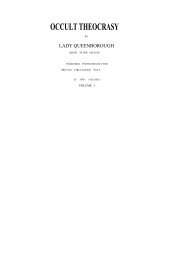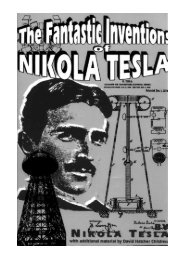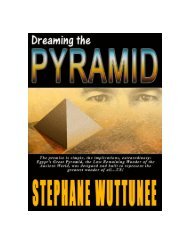the fantastic inventions of nikola tesla - Exopolitics Hong Kong
the fantastic inventions of nikola tesla - Exopolitics Hong Kong
the fantastic inventions of nikola tesla - Exopolitics Hong Kong
You also want an ePaper? Increase the reach of your titles
YUMPU automatically turns print PDFs into web optimized ePapers that Google loves.
I think, however, that in <strong>the</strong> case <strong>of</strong> an electrode immersed in a fluid insulating medium, and surrounded by<br />
independent carriers <strong>of</strong> electric charges, which can be acted upon inductively, a sufficiently high frequency <strong>of</strong> <strong>the</strong><br />
impulses would probably result in a gravitation <strong>of</strong> <strong>the</strong> gas all around toward <strong>the</strong> electrode. For this it would be only<br />
necessary to assume that <strong>the</strong> independent bodies are irregularly shaped; <strong>the</strong>y would <strong>the</strong>n turn toward <strong>the</strong> electrode<br />
<strong>the</strong>ir side <strong>of</strong> <strong>the</strong> greatest electric density, and this would be a position in which <strong>the</strong> fluid resistance to approach<br />
would be smaller than that <strong>of</strong>fered to <strong>the</strong> receding. The general opinion, I do not doubt, is that it is out <strong>of</strong> <strong>the</strong><br />
question to reach any such frequencies as might—assuming some <strong>of</strong> <strong>the</strong> views before expressed to be true—<br />
produce any <strong>of</strong> <strong>the</strong> results which I have pointed out as mere possibilities. This may be so, but in <strong>the</strong> course <strong>of</strong> <strong>the</strong>se<br />
investigations, from <strong>the</strong> observation <strong>of</strong> many phenomena I have gained <strong>the</strong> conviction that <strong>the</strong>se frequencies would<br />
be much lower than one is apt to estimate at first. In a flame we set up light vibrations by causing molecules, or<br />
atoms, to collide.<br />
But what is <strong>the</strong> ratio <strong>of</strong> <strong>the</strong> frequency <strong>of</strong> <strong>the</strong> collisions and that <strong>of</strong> <strong>the</strong> vibrations set up? Certainly it must be incomparably<br />
smaller than that <strong>of</strong> <strong>the</strong> knocks <strong>of</strong> <strong>the</strong> bell and <strong>the</strong> sound vibrations, or that <strong>of</strong> <strong>the</strong> discharges and <strong>the</strong> oscillations<br />
<strong>of</strong> <strong>the</strong> condenser. We may cause <strong>the</strong> molecules <strong>of</strong> <strong>the</strong> gas to collide by <strong>the</strong> use <strong>of</strong> alternate electric impulses <strong>of</strong><br />
high frequency, and so we may imitate <strong>the</strong> process in a flame ; and from experiments with frequencies which we<br />
are now able to obtain, I think that <strong>the</strong> result is producible with impulses which are transmissible through a conductor.<br />
In connection with thoughts <strong>of</strong> a similar nature, it appeared to me <strong>of</strong> great interest to demonstrate <strong>the</strong> rigidity <strong>of</strong> a<br />
vibrating gaseous column. Although with such low frequencies as, say 10,000 per second, which I was able to<br />
obtain without difficulty from a specially constructed alternator, <strong>the</strong> task looked discouraging at first, I made a<br />
series <strong>of</strong> experiments. The trials with air at ordinary pressure led to no result, but with air moderately rarefied I<br />
obtain what I think to be an unmistakable experimental evidence <strong>of</strong> <strong>the</strong> property sought for. As a result <strong>of</strong> this kind<br />
might lead able investigators to conclusions <strong>of</strong> importance I will describe one <strong>of</strong> <strong>the</strong> experiments performed.<br />
It is well known that when a tube is slightly exhausted <strong>the</strong> discharge may be passed through it in <strong>the</strong> form <strong>of</strong> a thin<br />
luminous thread. When produced with currents <strong>of</strong> low frequency, obtained from a coil operated as usual, this thread<br />
is inert. If a magnet be approached to it, <strong>the</strong> part near <strong>the</strong> same is attracted or repelled, according to <strong>the</strong> direction <strong>of</strong><br />
<strong>the</strong> lines <strong>of</strong> force <strong>of</strong> <strong>the</strong> magnet. It occurred to me that if such a thread would be produced with currents <strong>of</strong> very<br />
high frequency, it should be more or less rigid, and as it was visible it could be easily studied. Accordingly I<br />
prepared a tube about 1 inch in diameter and 1 metre long, with outside coating at each end. The tube was<br />
exhausted to a point at which by a little working <strong>the</strong> thread discharge could be obtained. It must be remarked here<br />
that <strong>the</strong> general aspect <strong>of</strong> <strong>the</strong> tube, and <strong>the</strong> degree <strong>of</strong> exhaustion, are quite different than when ordinary low frequency<br />
currents are used. As it was found preferable to work with one terminal, <strong>the</strong> tube prepared was suspended<br />
from <strong>the</strong> end <strong>of</strong> a wire connected to <strong>the</strong> terminal, <strong>the</strong> tinfoil coating being connected to <strong>the</strong> wire, and to <strong>the</strong> lower<br />
coating sometimes- a small insulated plate was attached. When <strong>the</strong> thread was formed it extended through <strong>the</strong><br />
upper part <strong>of</strong> <strong>the</strong> tube and lost itself in <strong>the</strong> lower end. If it possessed rigidity it resembled, not exactly an elastic<br />
cord stretched tight between two supports, but a cord suspended from a height with a small weight attached at <strong>the</strong><br />
end. When <strong>the</strong> finger or a magnet was approached to <strong>the</strong> upper end <strong>of</strong> <strong>the</strong> luminous thread, it could be brought<br />
locally out <strong>of</strong> position by electrostatic or magnetic action; and when <strong>the</strong> disturbing object was very quickly<br />
removed, an analogous result was produced, as though a suspended cord would be displaced and quickly released<br />
near <strong>the</strong> point <strong>of</strong> suspension. In doing this <strong>the</strong> luminous thread was set in vibration, and two very sharply marked<br />
nodes, and a third indistinct one, were formed. The vibration, once set up, continued for fully eight minutes, dying<br />
gradually out. The speed <strong>of</strong> <strong>the</strong> vibration<br />
<strong>of</strong>ten varied perceptibly, and it could be observed that <strong>the</strong> electrostatic attraction <strong>of</strong> <strong>the</strong> glass affected <strong>the</strong> vibrating<br />
thread; but it was clear that <strong>the</strong> electrostatic action was not <strong>the</strong> cause <strong>of</strong> <strong>the</strong> vibration, for <strong>the</strong> thread was most<br />
generally stationary, and could always be set in vibration by passing <strong>the</strong> finger quickly near <strong>the</strong> upper part <strong>of</strong> <strong>the</strong><br />
tube. With a magnet <strong>the</strong> thread could be split in two and both parts vibrated. By approaching <strong>the</strong> hand to <strong>the</strong> lower<br />
coating <strong>of</strong> <strong>the</strong> tube, or insulated plate if attached, <strong>the</strong> vibration was quickened; also, as far as I could see, by raising<br />
<strong>the</strong> potential or frequency. Thus, ei<strong>the</strong>r increasing <strong>the</strong> frequency or passing a stronger discharge <strong>of</strong> <strong>the</strong> same<br />
frequency corresponded to a tightening <strong>of</strong> <strong>the</strong> cord. I did not obtain any experimental evidence with condenser<br />
discharges. A luminous band excited in a bulb by repeated discharges <strong>of</strong> a Leyden jar must possess rigidity, and if<br />
deformed and suddenly released should vibrate. But probably <strong>the</strong> amount <strong>of</strong> vibrating matter is so small that in<br />
spite <strong>of</strong> <strong>the</strong> extreme speed <strong>the</strong> inertia cannot prominently assert itself. Besides, <strong>the</strong> observation in such a case is<br />
rendered extremely difficult on account <strong>of</strong> <strong>the</strong> fundamental vibration.<br />
The demonstration <strong>of</strong> <strong>the</strong> fact—which still needs better experimental confirmation—that a vibrating gaseous column<br />
possesses rigidity, might greatly modify <strong>the</strong> views <strong>of</strong> thinkers. When with low frequencies and insignificant









